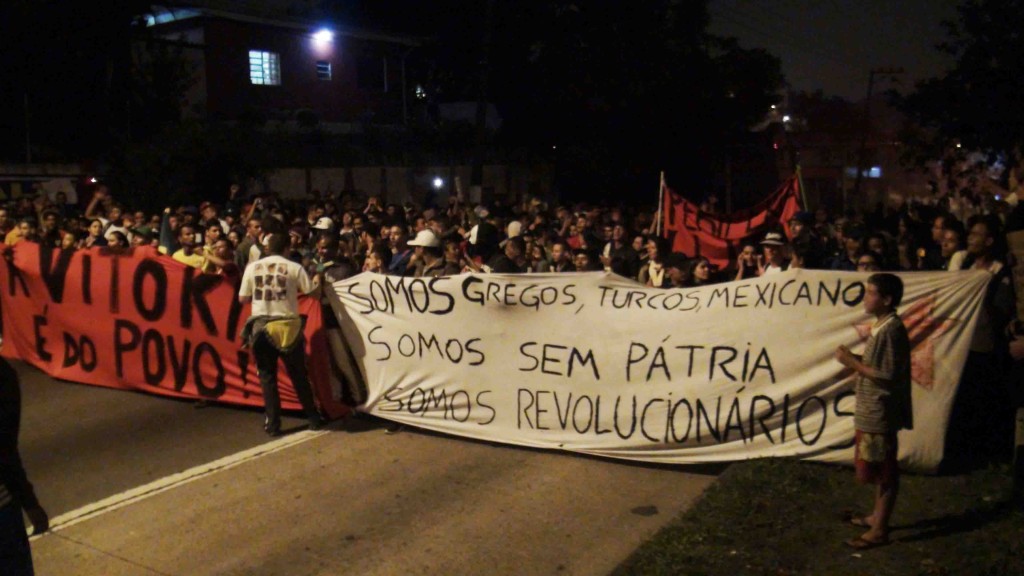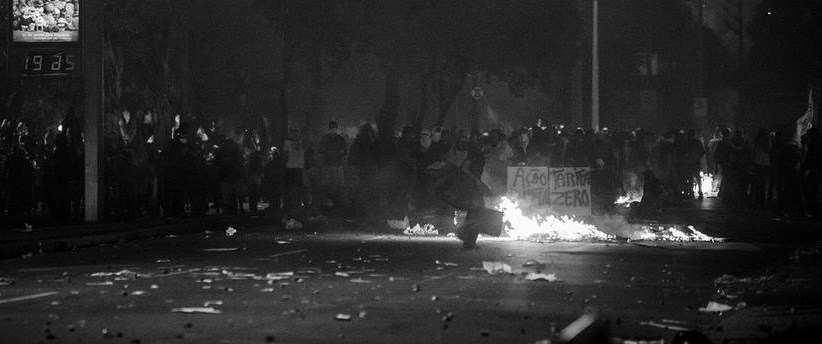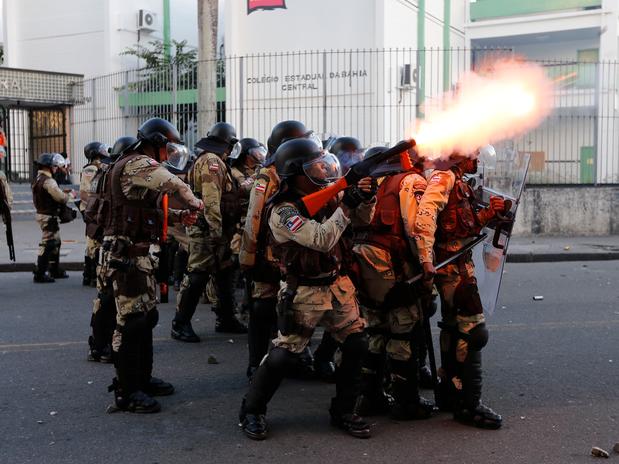Finally the Brazilian metropolises are living the moments that they haven’t seen since long ago. Since the beginning of June 2013, hundreds of thousands of protesters have taken to the streets of dozens of cities in the context of a struggle against a fare hike for public transit, as well as the devastating consequences of the 2014 World Cup and the 2016 Olympic Games.
The protests did not just emerge spontaneously, but are the fruit of a struggle that is nearly ten years old, from the massive demonstrations by the student movement against the fare hike in the bus system in the city of Salvador (in Bahia) in August and September of 2003 (also known as the Buzu Revolt) and the June 2004 protests, with the same goals, in the city of Florianópolis (known as the Tourniquet Revolt).
These 21st century revolts also have historical antecedents, assembled in the end of the 19th century with the popular revolt in Rio de Janeiro between 1879 and 1880 (the Vintém Revolt), when mules still powered the streetcars, or the Boats Revolt that took place on May 22nd, 1959, when the populace burned down buildings attached to the locks that allowed boats passage in the city of Niterói in Rio de Janeiro state, or the student strike of Fall 1979 in the city of São Luís (Maranhão state), which won a 50% reduction in tuition for the students.
This year’s protests confronted police repression from the beginning and, little by little, month by month, they multiplied and intensified, up to the explosion of the last few weeks.
Already in May, in Goiânia, the capital of Goiás state, four marches took place against the fare hike, with the march on the 28th of May being the most intense, both because of the level of repression brought by the cops, as well as the response by the protesters, who destroyed and burned busses.
In São Paulo the first march in June took place on the 6th, when thousands of protesters blocked traffic on various major thoroughfares with burning barricades, and confronted the cops, who used tear gas and rubber bullets to disperse the crowds. The marches on the 7th, 11th and 13th were also marked by police repression, mass arrests, and hundreds of wounded protesters, as well as active resistance by those who directly confronted the dogs of Power. Never the less, the demonstrations on June 17th in São Paulo as well as Rio de Janeiro and other cities, like Brasilia, Porto Alegre, Belo Horizonte, etc. were vast and much combative (see also a, b, c).
São Paulo, June 6th>
São Paulo, June 7th>
São Paulo, June 11th>
São Paulo, June 13th>>
On the 15th of June, the Internationalist Bolshevik League in Brazil claimed the following: ‘In the course of events, the “revolutionary Left” is being effectively aggregated and, generally, “disciplined” by the mass that has a series of preconceptions against the organizations which claim to be communists (use of red flags, cars with public address system, “disciplined leaders and chiefs”). Some anarchist sectors that radicalize themselves in form and street fighting reinforce this attack against those that they identify as Bolsheviks. (…) This political and ideological struggle on the inside of the movement can better define its future programmatic profile, given the fact that the semi-fascist Right is also intervening in the protests, resorting to nationalist props, flags of the countries, and moralizing axes (against corruption), thus diluting at first glance its reactionary character.’ These Trotskyists also mentioned that both the Workers’ Party (PT) and the Brazilian Social Democracy Party (PSDB) have been targeted by protesters.
São Paulo, June 17th>
In Rio de Janeiro, on the 17th, rebels attacked the Legislative Assembly, throwing rocks, Molotov cocktails and various objects, forcing the forces of order to retreat into the building, and then setting fire to the doors. At a certain point during the confrontations in Rio de Janeiro, the pigs actually used live ammunition against the protesters.
Rio de Janeiro, June 17th: Cops open fire with real ammunition.>
Rio de Janeiro, June 17th: Protesters dose the cops with a bit of the violence that they spread daily.>>
http://www.youtube.com/watch?v=Z42021t2Vbs
Pampulha, Belo Horizonte, June 17th>
http://www.youtube.com/watch?v=Df1y3sYVjvw
Rio de Janeiro wider metropolitan area: Clashes in Niterói on the 19th>
According to a libertarian socialist reading of the insurrection (from June 20th), the demonstrations that spread throughout Brazil came as a result of abusive increase in public transport fares, in solidarity with the struggle that began in São Paulo, and against the FIFA mega-events (the 2013 Confederations Cup and the 2014 World Cup). In Belo Horizonte, in particular, the II Seminar of the COPAC (Committee of People Affected by the World Cup) was held between the 13th and 17th of June 2013, and more than 60,000 took to the streets in two major demonstrations (the 15th and 17th of June), a street mobilization that had not been achieved for more than two decades. Actions lasted more than six hours, blocking all lanes of the city’s busiest avenues, while people took to the streets decisively and confronted the violent police repression. Giant public spaces were occupied by crowds, who do not discuss anything these days beyond the current state of things in the city and the whole country.
People on the streets have their conscience, their solidarity and dreams, and at most few stones and Molotov cocktails. Windows of bank branches and cars smashed, protest graffiti painted, stone-throwing and flaming barricades cannot even be compared to the financial, political and physical violence that most people are suffering daily —and even more so in the context of the Cup. However, the mainstream media insist on giving a positive connotation to ‘pacifist demonstrations’ and continue in their traditional line of defaming the so-called ‘violent ones.’
Live poll on Brazilian protests goes wrong.>
A reproduction of this discourse about counter-violence and peaceful protest can clearly be perceived among protesters, too. When some comrades dare to attack symbols of FIFA or big enterprises that fund the Cup, several other demonstrators immediately reject their actions and repress them. Meanwhile, the State has a well-equipped army and the police (an investigative and a military one). The military police commands dozens of battalions (Choque squadrons, tactical/special units, cavalry, dogs, etc.), with their vehicles, helicopters, tanks, bombs (moral effect, tear gas, and pepper spray grenades) and various weapons (lethal, rubber bullet, stun guns, etc.).
The proportions that protests took in the whole of Brazil were not really anticipated, and became extremely worrying for our enemies. More than 500,000 hit the streets across the country—100,000 in São Paulo alone, which is internationally regarded as the country’s economic centre. But in fact fear can never be caused by any mobilization heading peacefully—criminalizing those who are labeled as violent—with people shouting “down with corruption”, “the giant woke up”, “Renan (Calheiros, president of the Senate) out”, and “Dilma (Rousseff, president of Brazil) out” while they carry national flags of Brazil. The enemy’s great fear is the situation of combativeness itself, which began in São Paulo and then erupted in the capitals of other Brazilian states. The ticket price reduction claim, the rejection of FIFA for all the social and economic disasters it has inflicted, as well as the repudiation of police violence, accompanied by combative demonstrations with confrontational character, are certainly more dangerous than those slogans about corruption and current governors, or any pacifist and patriotic chants, because they directly attack one of the roots of social problems and dismantle the discipline and control, imposed on the rebels by the State and our every other enemy in order to maintain Capital, exploitation and oppression.
The Military Police of the Minas Gerais state (PMMG) has made infuriating efforts to win protesters over. For example, they appointed one of their colonels (Cláudia Romualdo) to play friends with demonstrators; she also commanded an anti-riot squadron to walk blind people across a street amid a large demonstration, while she was gladly photographed with demonstrators who had the Brazilian flag wrapped around their body. This is a pacification strategy of the local military police, which already showed its true face attacking fiercely at 50,000 people of all ages that tried to march towards the Mineirão stadium. Moreover, the military police made sure to collaborate closely with the media at times, when e.g. groups attacked the city hall and looted shops without any reprisals from the cops, who watched from a distance while media cameras recorded their partial content with clear intent to criminalize the movement.
A strategic infiltration of organized right-wingers is also very noticeable in demonstrations. Undistinguished members of historically right parties (PSDB, DEM, etc.) or right-wingers not affiliated to parties are promoting their hideous slogans, and encourage practices (like handing persons who painted graffiti over to the police, lynching radicalized protesters, and so forth) that should be denounced by every rebel. Last but not least, the use and reproduction of national symbols should be repudiated. A national anthem and a national flag are symbols that represent over 500 years of people’s drama and exploitation perpetrated by the elites. The motto on the national flag, “Order and Progress”, makes it clear what this symbol stands for. The same national and patriot sentiment was used to deceive the populace during numerous contexts of social conflict, from the Vargas dictatorships (1930–45, and 1951–4) and the military junta (1964–85) to the present day.
In Porto Alegre, on the 20th, cops raided the space of the Gaúcha anarchist federation (FAG).
Rio de Janeiro, June 20th>
Media reported that an anarchist bloc in São Paulo openly defied patriots on the 20th of June. Anarchists were chanting slogans like “A patriot is an idiot!” and “The national flag is a tribute to slavery.” On the same day, various reports from different cities in Brazil described almost a state of counter-revolt by patriots/nationalists. Another reportback confirming nationalist attacks here; reportback from demos in Fortaleza, also witnessing incidents with patriots that repressed protesters who made graffiti, here.

Belo Horizonte, June 22nd>
http://www.youtube.com/watch?v=XSHyKSklfUU
Great confrontation on the 22nd of June under the full moon in Belo Horizonte. The anti-Cup mobilizations are becoming increasingly radical, though many fluffy guys still criticize and try to isolate individuals who undertake the most daring direct actions. Under the populace’s anti-capitalist fury, car dealerships and bank branches were destroyed on the Antonio Carlos Avenue (which is the path leading to the Mineirão stadium, where a football match of the FIFA Confederations Cup, or more accurately Deceptions Cup, was due to take place). Beneath the Jose Alencar overpass, protesters clashed with the FIFA Guard (a mixture of the Minas Gerais military police, the National Guard, and organs of the World Cup Laws) under the slogan “kindness generates kindness.” Stun grenades (moral effect bombs) and tear gas were in abundance. Two police helicopters further worsened the chemicals’ effect, making close flybys and spreading tear gases on to the protesters. Rubber bullet shots were heard all the time, resulting in injured people. Amid the turmoil, demonstrators found one capsule of lethal ammunition. People defended themselves with makeshift shields and barricades, and responded with stones at police attacks chanting slogans like “The people united will never be defeated.” At one point, the police cavalry had to retreat before the counter-attack of protesters, which was greeted by everyone’s shouts. A 17-year-old apparently fell from the overpass and was hospitalized, but it’s not yet known whether the teenager is at risk of death or not.
Much is expected ahead of the General Strike, on the 1st of July. The streets are calling.
—Friends of Insurrection

There’s no way (for us) to confirm the total number of arrested, detained, injured or dead protesters as of yet.
Reports by UNIPA (Anarchist Popular Union) i, ii, and multilingual call for international solidarity by the same organization.
So, the fuse is lit in Brazil, too; “the love is over, and Brazil will go the way of Turkey,” as some protesters said. Beyond any analysis or words, what’s important is to keep the flame alive and spread the insurrection that is coming more and more intensely against any and all icons of Power. We call our anarchist comrades who are living the happenings of the Brazilian revolt firsthand to contribute news from the streets, reiterating the suggestion for an international campaign of agitation and direct action against the World Cup and the Olympics. Let’s not leave our comrades alone in their struggle on the streets of Brazil. Incendiary international solidarity!












